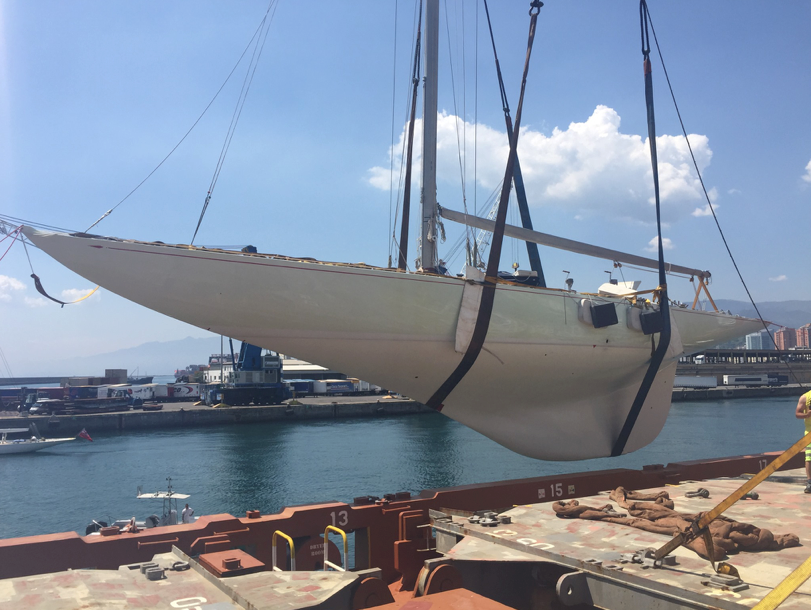Kid gloves at the ready
To ship a classic yacht requires a slightly different sort of careful treatment.
The ability to reliably ship yachts around the globe is a prerequisite for many of today's regattas. As with state-of-the-art racing yachts, Sevenstar recognizes that classic yachts of all sizes and descriptions need special attention. “These are unique yachts that are often similar to works of art and must be treated with the greatest of care”, says Sevenstar's classic yacht expert Matthieu Le Bihan.
Sevenstar transports roughly 3,000 yachts a year on its vessels, so the master, officers, and crew all have a clear understanding of the processes involved. In any industry, the calibre of clients is a good endorsement and Sevenstar has long-running close relationships with many owners and project managers. These include America's Cup legend Bruno Troublé, who has re-established the 55ft P Class from the early 20th century. “We have already transported three boats for him and are now making plans for a fourth”, says Le Bihan.
Another regular is Rémy Gérin, a member of Yacht Club de France who owns Faïaoahé, a 20-metre (65ft) modern classic and is passionate about solo and double-handed races. Sevenstar has shipped his yacht back to Europe after both the RORC Transatlantic Race and the Route du Rhum. The firm is also currently working on logistics to get the boat back from New York after this year's CIC Transat race. “The considerations are different for a yacht with a long keel than for modern cruising and racing yachts”, says Le Bihan. “They are heavier and the center of gravity tends to be in a different place.” The correct lifting equipment is therefore essential - Sevenstar's ships are equipped to lift yachts of up to 2,000 tonnes displacement. To put that in context, the giant J Class racing yachts, many of which are also regularly transported by Sevenstar, weigh only 160 -180 tonnes.

Extra strops are often needed and, when necessary, Sevenstar has divers on hand to ensure these are placed exactly where the lifting plan drawn up by the in-house engineering department specifies. Wherever possible, this is based on the yacht designer's original drawings. “We're very lucky in the classic yacht world that these are often available.”
Nevertheless, it's still important to ascertain that the boat has not undergone subsequent changes. Preparation for shipping is similar in some respects to winterizing a yacht, including taking all sails and canvas off, plus securing anything that's left on deck. To reduce displacement, it's also worth ensuring tanks are as near to empty as possible. It's possible to use a yacht's cradle, though the engineering drawings need to be checked before transport – regular yacht cradles may not be able to support the dynamic loads experienced at sea - and most classic yachts use Sevenstar's cradles and supports.
Yachts can also be shipped with the rig in place, which cuts down on preparation time once the yacht arrives for the next event. Once the yacht is on board the ship Sevenstar's loading masters will tap the hull, similarly to a surveyor, as a double-check that supports are placed against appropriate frames and bulkheads, as per the loading plan.
The upper limit of wind strength in which loading will take place varies with different locations, partly because it also depends on the sea state. An advantage of using a service that owns the ships used for transport is that it has a greater degree of flexibility when faced with a prolonged period of bad weather.
“If the weather is risky for loading there's not the same pressure for us to move on immediately if it's not sensible,” says Le Bihan. This overall level of care is also reflected in the insurance rate Sevenstar pays for each yacht it ships. Le Bihan says this is: “One of the lowest in the market, reflecting that we have the best safety procedures and processes in place for safe transport.” This insurance is effective from the moment the first mooring line is taken by the ship as the yacht comes alongside, to the moment the final one is cast off in the destination port.
Popular routes include North Europe to the Mediterranean and back, which operates monthly from March to September. The thriving classic yacht scene in the northeast of the USA means this area is also well served, both from the Mediterranean and Northern Europe, including several direct sailings to Newport, Rhode Island. There are also seasonal services to and from the Caribbean.